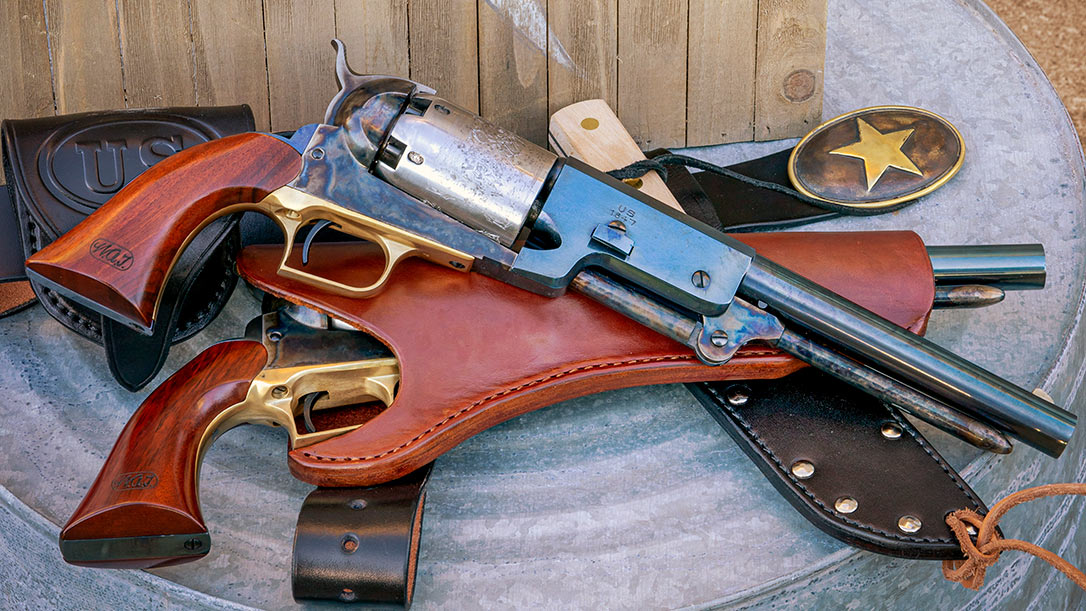“Yesterday’s gone, and we can’t get it back.” Augustus “Gus” McCrae made this sage remark. McCrae was a former Texas Ranger captain and one of the main characters in the Pulitzer Prize–winning book Lonesome Dove (1985) by noted author Larry McMurtry. This novel was adapted into a screenplay, spawning a four-episode, Emmy Award–winning TV miniseries in 1989. Not to mention a brace of Colt Walker revolvers from Cimarron Firearms.
Lonesome Dove Walker Colt Revolvers
The series has become an iconic Western, retaining its popularity to this day. McCrae and his partner Woodrow F. Call, also a former Ranger captain, have retired to rundown, dusty town on the Texas-Mexico border called Lonesome Dove. McCrae and Call are the proprietors of the Hat Creek Cattle Company & Livery Emporium.
Two other former Rangers, a Mexican cook, and a 17-year-old boy believed to be Call’s son assist them. Another former Ranger and partner, Jake Spoon, arrives in Lonesome Dove with tales of the beautiful and largely unsettled Montana Territory.
Advertisement — Continue Reading Below
This inspires Woodrow Call to gather together a herd of cattle and a remuda of horses to drive to Montana. The plan is to start the first cattle ranching operation there. He convinces Gus to join the venture, and they gather together some drovers to help on the long journey.
Adventures and misfortunes abound as the herd and men cross hundreds of miles of wilderness. Along the way, they fight the elements, bad men, hostile Indians, and each other, to finally reach Montana.
McCrae and former Ranger Pea Eye Parker are riding ahead of the herd when Indians attack them. Gus is wounded and barely survives, only to have his leg amputated, but too late to save his life. A despondent Woodrow Call promises to bury his friend near Lonesome Dove. The following spring makes an epic overland journey back with the body, finally keeping his pledge.
Advertisement — Continue Reading Below
Colt Walkers
Colt and the Texas Rangers have long histories. Samuel Colt sold several of his Paterson Belt Revolvers to the Republic of Texas Navy in 1839. And when that Navy was disbanded in 1843, the surplus revolvers were turned over to the Texas Rangers. The five-shot, .36-caliber percussion revolvers were used effectively against hostile Comanches. But that didn’t prevent Colt from going out of business.
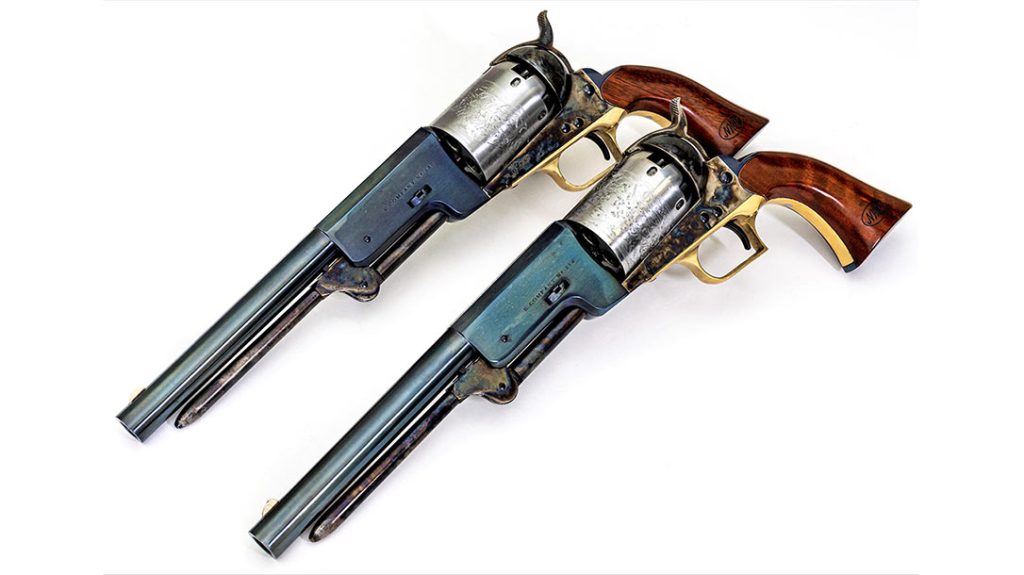
During the Mexican War, former Ranger Samuel Walker, serving as a captain in the U.S. Mounted Rifles, met with Sam Colt in 1846. This meeting resulted in the Colt Walker revolver.
Advertisement — Continue Reading Below
This huge .44-caliber percussion six-gun was a horse pistol, both powerful and accurate. The Ordnance Department ordered 1,000 of these revolvers for the Mounted Rifles. Correspondingly, they include a mark for each company with “Company A,” and so on, through Company E.
Whether any of these Walkers ended up with the Texas Rangers is lost to history. However, considering that many Rangers fought in the Mexican War, there’s little doubt that some did.
Mike Harvey, the founder and CEO of Cimarron Firearms, chose to honor Lonesome Dove with a brace of two Colt Walker reproductions. The revolvers have names corresponding with the two main characters in the tale: the Woodrow F. Call version and the Augustus McCrae.
Advertisement — Continue Reading Below
Mike believes the mission of Cimarron Firearms is to “. . . create seriously authentic replicas . . . the actual types of guns a Texas Ranger would have been issued . . .”
Both of these cap-and-ball six-guns are certainly faithful to the last detail.
The Cimarron Walker Colt
The 9-inch barrel has a rich charcoal-blue finish. Likewise, so do the backstrap of the grip frame and the frame screws. The huge cylinder is “in the white” and engraved with a “dragoon and Indian” battle scene. This cylinder is realistic—a Walker with the same style cylinder is on display in The Metropolitan Museum of Art in New York City.
Advertisement — Continue Reading Below
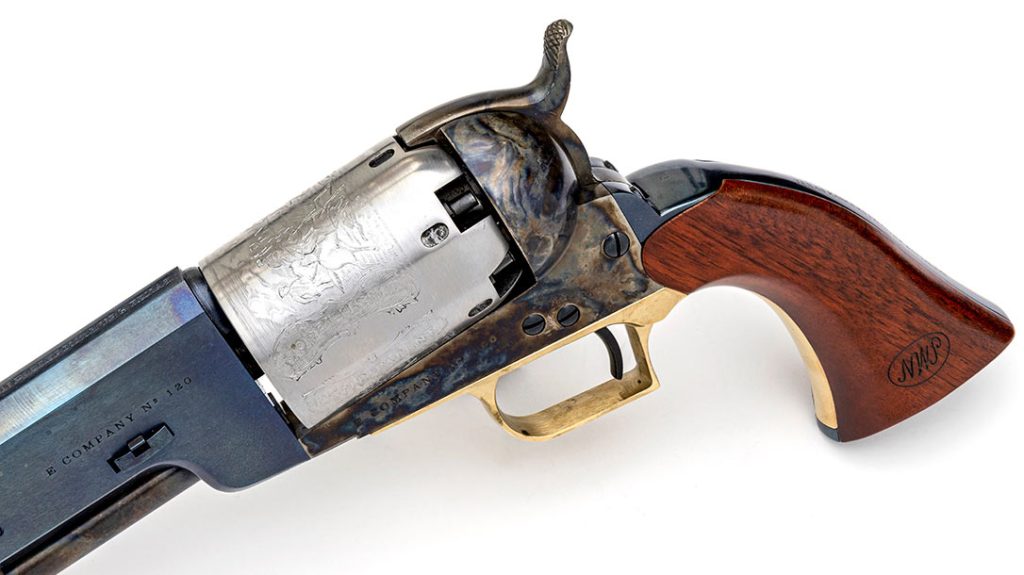
The frame, loading lever, hammer, and trigger have a beautifully mottled color-casehardened finish. Finally, the frontstrap/triggerguard unit is polished brass, and the front sight blade is German silver.
An Ordnance Department inspector’s cartouche is stamped into both sides of the finely figured walnut stock. Fit and finish are first-rate, and the six-guns are visually stunning.
Advertisement — Continue Reading Below
It is the special markings that set these Walker revolvers apart. On the right side of the barrel, just above the cylinder pin wedge, both revolvers feature the mark “US 1847.”
On the opposite side of the barrel, in the same location, is stamped “E Company No. 119” on the Call model and “No. 120” on the McCrae model. Interestingly, E Company received only half as many Walker Colts as the other companies.
Gus and Woodrow were members of the Frontier Battalion of the Texas Rangers. Their territory was West Texas and the Big Bend area. Each commemorative Walker has engraving on the backstrap with either “Capt. Woodrow F. Call Texas Rangers Frontier Battalion” or “Capt. Augustus McCrae Texas Rangers Frontier Battalion.”
Advertisement — Continue Reading Below
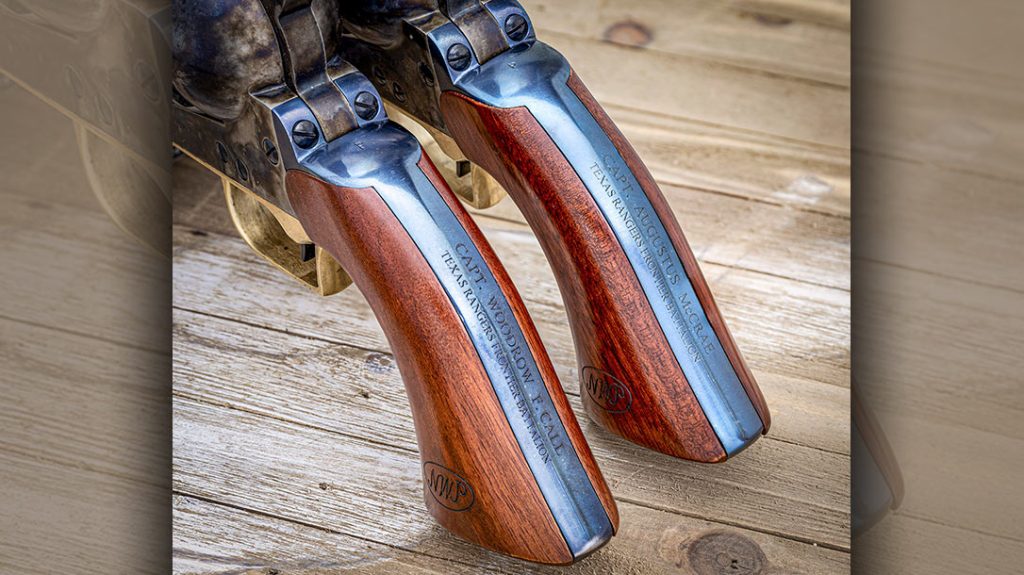
The names appear above the assignments. Serial numbers begin with LD, and mine are LD0009 and LD0129.
Chisholm’s Trail Old West Leather
What better for this article about the Cimarron Lonesome Dove Walker revolvers than to have a leather rig styled like the one in the TV miniseries? In this case, the leather gear is a reproduction of what was worn and used by Capt. Gus McCrae. This is the creation of the talented team of Alan and Donna Soellner, the “honchos” of Chisholm’s Trail Old West Leather.
Advertisement — Continue Reading Below
Alan, a descendent of Jesse Chisholm, who blazed the first cattle trail north out of Texas, does a lot of the research for the holster rig projects and is a skilled leather craftsman. Donna comes from a leather-making family. Her father tanned leather and her mother colored it for the Lawrence Leather Company, an outfit many readers are probably familiar with.
Together, they make some really high-quality products. You really need to visit their website!
Capt. Gus McCrae’s Rig
Gus wore some leftovers from the Civil War, and his belt was the usual garrison-style, black-dyed, unlined leather. The buckle is an oval-shaped military style, worn by Texas troops. This Chisholm’s Trail buckle is an exact copy of the one Gus wore (played by Robert Duvall). In fact, the original mold was used to produce it.
The front of the buckle is brass, with a Texas star attached over a lead baseplate. This is just the way they used to make them. The attachment is on the right side of the belt, opposite from what is customary on men’s belts.
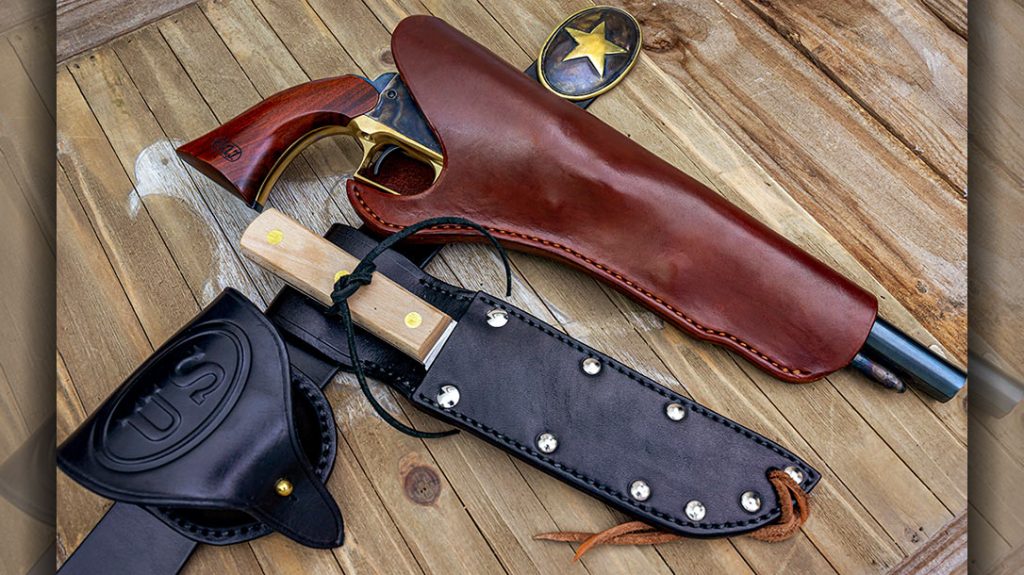
Gus also wears a captured Union cap box on the belt. From what I understand, Confederate soldiers would scratch off the U.S. emblem that adorned the flap of the cap box. The holster is a slim jim style, with a mahogany coloration. Gus wears it cross-draw, and the open-ended holster is not quite long enough. As a result, the barrel of his Walker protrudes a couple of inches from the end of his holster.
Typical of Westerners, Gus also wears a black leather sheath, containing a Green River Skinner knife made by John Russell Cutlery Co., Green River Works.
This was an extremely popular knife on the frontier, as its high carbon steel held an edge and was almost stainproof. This reproduction has wood handles riveted to the blade. There’s even a hand-lettered label on the handle warranting the blade’s forging and tempering.
All this leather gear is stamped with the Chisholm’s Trail brand label, along with “GOW WIN 22 GUS.”
Note that the leather seen on TV has the distressed look!
Out on the Range
Now, some people might say that these Lonesome Dove Walker Colts are too pretty to shoot. Well, partner, no firearm passing through the hands of La Vista Bill can be considered properly evaluated until it’s had some powder burnt in it!
The Walker is a .44-caliber cap-and-ball or percussion revolver. Traditionally, these revolvers are loaded with loose powder and ball and set off by a percussion cap.
For this test, I used commercial lead balls from Hornady, sized 0.451 inch. My black powder was FFFg from Goex, and I decided on a 30-grain charge. A 50-grain charge could safely be used in a Walker Colt in battle. I used Winchester No. 11 percussion caps for ignition.
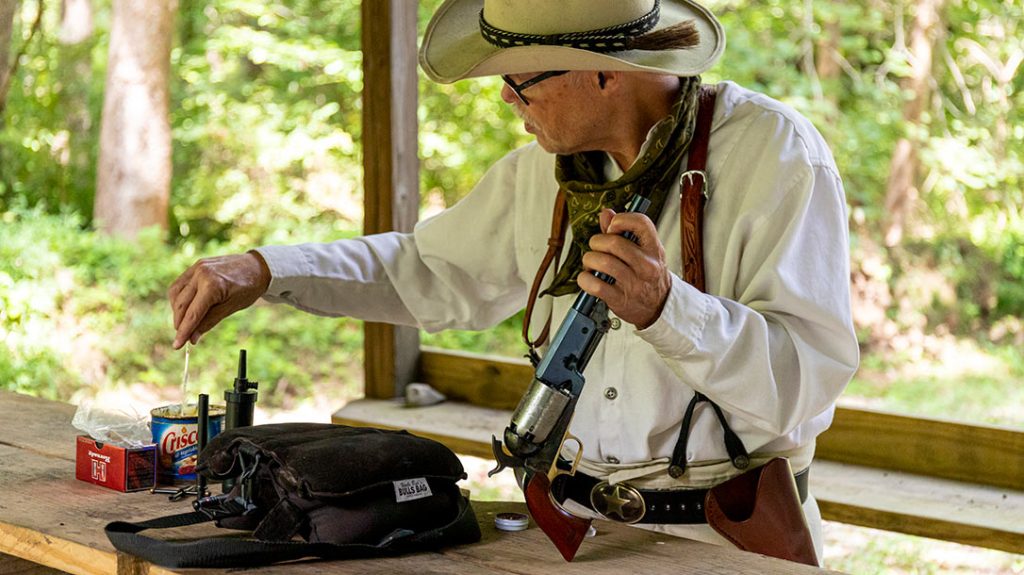
A measured amount of black powder was poured into the open end of each cylinder chamber. The lead ball was then pressed into place using the ramming lever below the revolver barrel.
I topped off each chamber with vegetable shortening. This helps prevent chain fire, that is, the flame from one chamber setting off another. It keeps the blackpowder residue in the barrel’s rifling soft, allowing for more accurate repeat shots.
A word to the wise: Take your time—you don’t want to press a ball into an empty chamber. The final step before shooting was to put a cap on each nipple at the rear of the cylinder.
Putting Rounds on Target
I decided that a practical distance for my accuracy potential evaluation was 15 yards. The crude rear sight on these six-guns is a V-notch cut into the hammer nose. The front sight blade pretty much fills up what you can see in the notch. I always use a big target when shooting these percussion revolvers, because no matter how well made they are, you never know where the sights are going to shoot to.
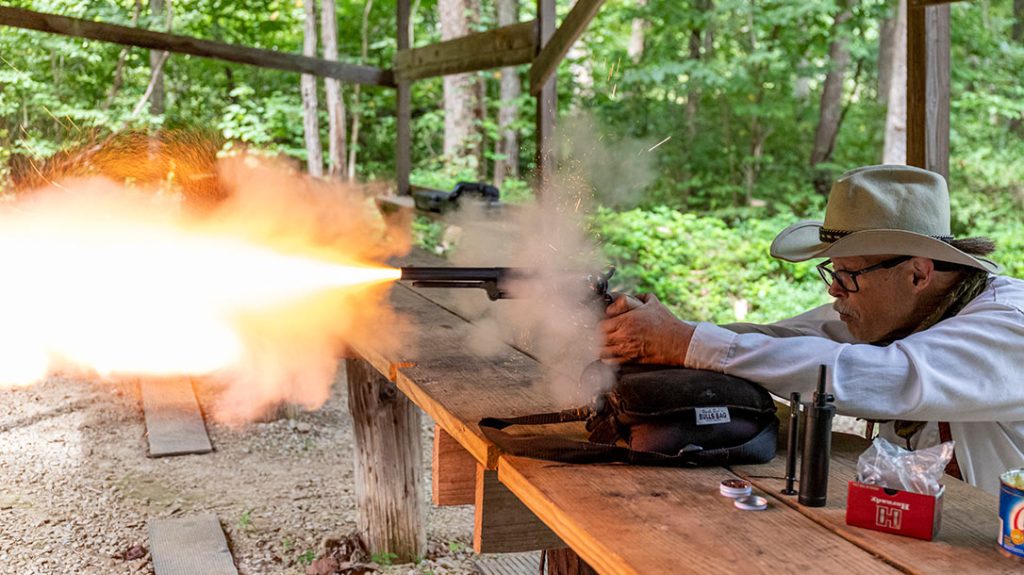
I used a wooden bench and a sandbag rest to steady the huge, heavy six-gun—they weigh 4.5 pounds empty! All shooting was done single-action, as the Walker Colt is a single-action revolver.
I fired five shots for a group and a total of three five-shot groups. My point of aim was dead center of the target at the X-ring. Imagine my surprise (a pleasant one) when the first shot hit just above my point of aim. So did most of my other shots.
My best five-shot group measured just 1.61 inches, the next best was 2.01 inches, and the largest was 3.42 inches, for an average of 2.35 inches. Certainly, this level of accuracy was better than expected and more than adequate for Cowboy Action Shooting.
Cowboy Action Shooting
Repairing to the Cowboy Town range, I shot a couple of cylinders full at steel Cowboy Action Shooting targets. Some were as close as 5 yards, and others as far out as 25 yards. I was shooting one-handed, and found that holding this gun out at arm’s length for very long is a challenge. Nevertheless, I could hit all the steel targets without much difficulty.
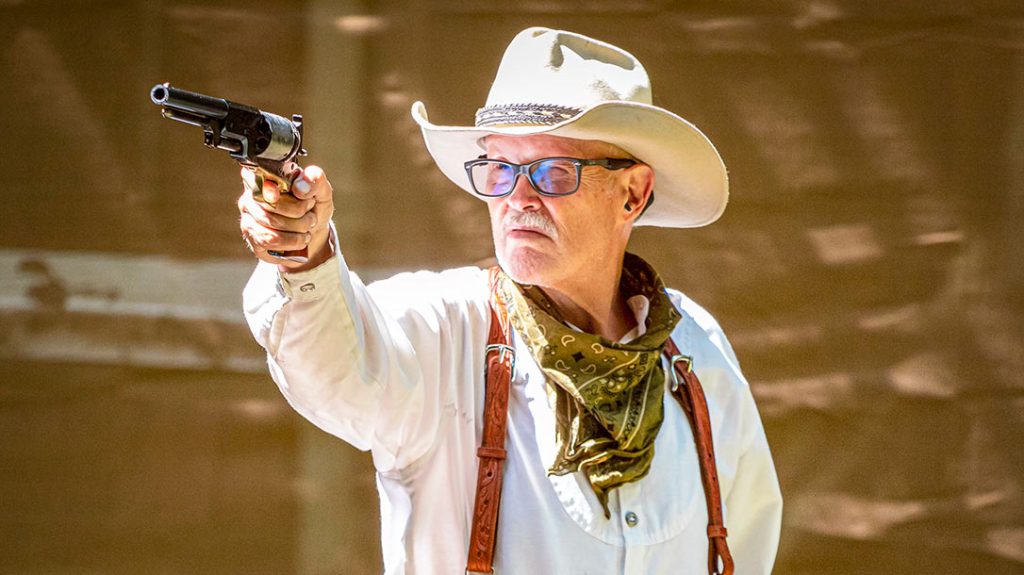
During my time at the shooting range, I didn’t have a single issue with the Cimarron Lonesome Dove Walker commemorative.
I didn’t shoot both guns—I’d decided to use just the Gus model, as I was wearing the Gus leather. I’m sure the Woodrow gun would shoot just as well.
Cleanup with a cap-and-ball revolver is fun (not!). Especially when trying to get a test gun all spiffed-up for photographs. Black powder is corrosive, so do the job in a timely manner after shooting—and be thorough.
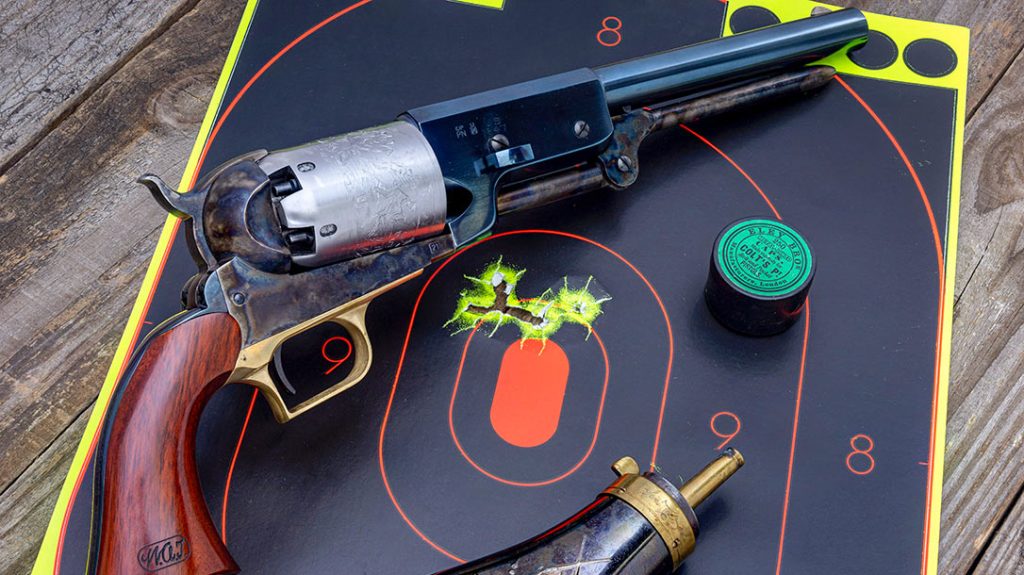
Back at Lonesome Dove
If you’ve never seen the Lonesome Dove miniseries, and you’re reading this magazine, you owe it to yourself to find the DVDs or stream it and binge-watch on one of the many channels today.
Larry McMurtry’s novel Lonesome Dove also inspired three spin-offs: Streets of Laredo, Dead Man’s Walk, and Comanche Moon. There was also a sequel miniseries, Return to Lonesome Dove, in which Jon Voight plays Woodrow Call in place of Tommy Lee Jones, who portrayed the original Woodrow.
I guarantee all these Westerns will get you fired up to go out and burn some powder and shoot some lead. I don’t believe we could bestow any better honor on this iconic series than these handsome Walker Colt reproductions by Cimarron Firearms. And certainly, if you want the best in Gus or maybe even Woodrow leather, you won’t find anything better than the products from Chisholm’s Trail Old West Leather.
For more information, please visit Cimarron-Firearms.com and WesternLeatherHolster.com.
Cimarron Firearms Lonesome Dove Colt Walker Specs
Caliber: .44 ball or conical bullet
Barrel: 9 inches
Overall Length: 15.75 inches
Weight: 4.5 pounds (empty)
Sights: Blade front, V-notch rear
Stocks: Walnut
Action: Single Action
Finish: Charcoal blue barrel, color-casehardened frame
Capacity: 6
MSRP: $740.00
This article was originally published in the Guns of the Old West Winter 2022 issue. Subscription is available in print and digital editions at OutdoorGroupStore.com. Or call 1-800-284-5668, or email subscriptions@athlonmediagroup.com.
